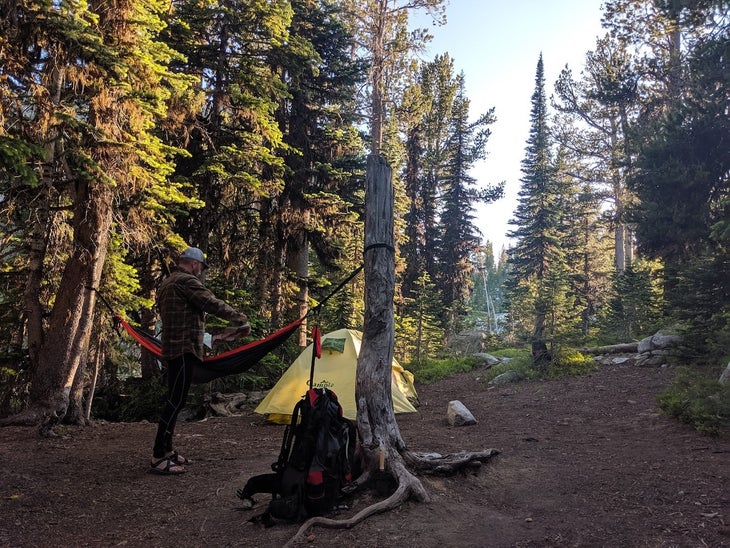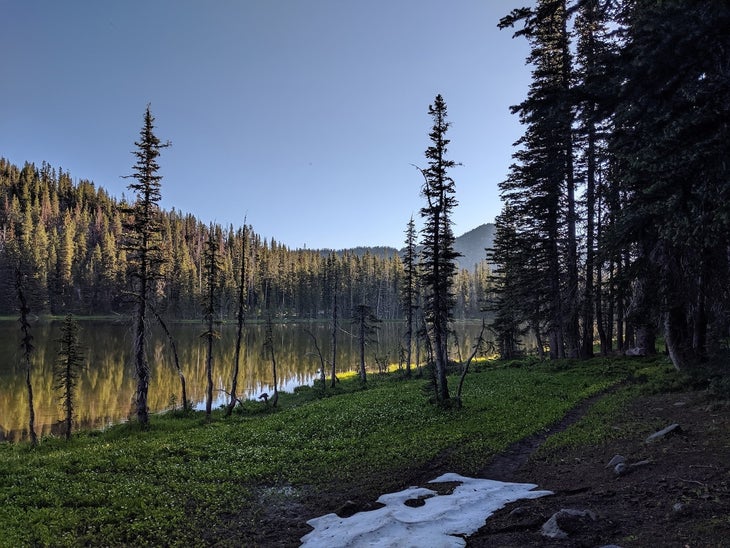Heading out the door? Read this article on the new Outside+ app available now on iOS devices for members! Download the app.
Tucked away in northeastern Oregon is one of the most stunning and overlooked hikes in the entire Pacific Northwest: the Elkhorn Crest Trail. Often described as Oregon’s version of the Sierra High Route—rugged, exposed, and breathtaking—this trail stays above 7,000 feet and offers unparalleled isolation and panoramic views.
For my 20-year-old daughter and me, our Elkhorn Crest hike was more than just another backpacking trip, it was a continuation of our annual adventure. We’re always on the lookout for someplace new to explore, and this year, that search led us to the Elkhorns. What we found there didn’t disappoint.
If you’re looking for an off-the-beaten-path trek that delivers epic scenery, solitude, a good challenge, and a touch of awesome, this is it. Here’s everything you need to know to plan your own Elkhorn Crest hike.
The Overview
- Distance: 22-27 miles, one way (mileage depends on detours)
- Altitude: Stays mostly above 7,000 feet with long, exposed sections
- Difficulty: Moderate to strenuous (due to exposure, elevation, and limited water)
- Best time to go: July through September
- Permits: None required
Why It Belongs on Your List
Few trails will leave as strong an impression as this one. Maybe it was the sweeping views of Baker Valley to the east and the Blue Mountains to the west. Maybe it was camping beside pristine remote lakes that we had all to ourselves. Or maybe it was seeing the rare family with kids lugging backpacks half their size, trekking up the trail with fishing poles in tow. Whatever it is, this hike remains an underappreciated destination that offers solitude without the crowds that flood Oregon’s more famous trails.
The Route + Logistics
Most hikers tackle the Elkhorn Crest Trail as a one-way, point-to-point hike starting at Marble Pass (southern trailhead). This south-to-north route is more popular because there’s less climbing. As with most of life’s best experiences, there’s a catch. You’ll need to arrange your own ride for drop-off and pickup. A local shuttle company used to serve the area, but they’ve recently closed shop, so hikers now have to get a little creative. With some extra planning, it’s still very doable—and absolutely worth it.
The road to Marble Pass is rough and steep, so a high-clearance vehicle is recommended (along with a friend willing to tackle the drive). The trail ends at Anthony Lakes, a scenic finale with deep-blue alpine waters and postcard-worthy views.
For those who prefer an out-and-back dayhike, starting at Anthony Lakes and hiking to Angel Pass offers a stunning high-country experience with less commitment at only 3 miles.
Where to Top Off Your Water Bottles
Although snow can hang out here until summer, water is scarce along the ridgeline, and most reliable sources require steep descents off the main trail. Keep in mind that these detours can add significant distance and elevation change to your hike. Here’s where to fill up:
- Twin Lakes (7,700 ft): A 1.25-mile descent about 4 miles in, popular for camping.
- Rock Creek Lake (7,680 ft): Requires a hike down into the basin.
- Summit Lake (7,100 ft): About 10 miles in, a beautiful but remote water source.
- Lost Lake (8,100 ft) and Dutch Flat Lake (7,400 ft): Accessible from side trails as you get closer to Anthony Lakes.
Know before you go: Play it safe and check in with the local ranger station in Baker City at 541-523-6391 for updated water info before you go. Also, high-altitude springs and lakes can carry unwelcome surprises, so as a best practice, always filter or treat your water.
Exposure and Trail Conditions
The Elkhorn Crest is a true ridgeline hike, meaning you’re exposed to sun, wind, and sudden weather changes. On our hike in mid-July, the section near Lost Lake gifted us a particularly steep traverse across an avalanche zone that proved more mentally challenging than physically dangerous. My daughter, usually unfazed by heights, froze mid-trail, gripping my hand tighter than she had since she was little. Step by step, we made it across together. It reminded us that in the mountains, sometimes a short distance can feel very long. Take your time, slow down, and simply breathe.

Gear Considerations
On the Crest, you’re often exposed and the terrain is rugged. So lightweight but sturdy gear is key. Here are a few other important bits of gear and preparation to keep in mind:
- A reliable tent or bivy: Nights can be windy.
- Extra water capacity: The main Elkhorn Crest Trail has long stretches without direct water access. Hikers should plan to carry enough water between these sources.
- Carry a minimum of 3 liters: Better to be safe than sorry.
- Layer up: Temps can drop fast at elevation, so pack and dress appropriately.
- Bug protection: Mosquitoes can be relentless at lakes in early summer.
- Lip and skin protection: The higher you get, the drier it gets. Be aware of the otherworldly intensity of the sun.
- Navigation tools: Not all signage is standing or even present, so download a map on your phone or go analog and bring an old school map. My daughter and I didn’t pack either navigation tool. If we hadn’t chatted up a couple the day before, we would’ve totally missed our turnoff for Summit Lake (which was marked with a cairn).
- Bonus tip: We witnessed—and walked through— a full-on cloud of monarch butterflies. July and August is peak season for these tiny winged creatures, and seeing them at their best is like witnessing a butterfly supernova.
The Wildlife + Solitude
One of the greatest joys of this trail is its remoteness. Other than your party, you might not see another person for miles—or days—except for the occasional backpacker or ambitious trail runner. Here, your company comes in the form of wildlife:
- Mountain goats graze along rocky slopes, sometimes wandering near campsites.
- Black bears are rare but present, so pack a bear canister or practice hanging your food.
- Wolves? A game warden we met chuckled when my daughter expressed relief at there being no wolves. “Oh honey,” he said, “there are wolves out here.”
Our second morning, we woke to deep, rhythmic thuds outside our tent. Peering out, we found ourselves surrounded by at least a dozen mountain goats. They were eyeing us with a mix of curiosity and indifference. For several minutes, we just watched, totally mesmerized. They seemed perfectly content just sharing the high country with us for a little while—and I’m grateful they didn’t go for our boots.

Making It Family-Friendly
While the full hike is best suited for experienced backpackers, families with kids can still enjoy the magic of the Elkhorn Crest. A great option is to start at Anthony Lakes and hike a short, out-and-back section. The first few miles offer alpine lakes, stunning views, and plenty of opportunities for kids to explore without committing to the entire trail. Lost Lake (4.5 miles from Anthony Lakes) is a great destination for families and is a solid spot to cast a line.
The Verdict
The Elkhorn Crest is wild, rugged, and demanding. But if you’re up for the challenge, it will reward you with solitude and gorgeous scenery. Just keep an eye out for the mountain goats.
From 2025